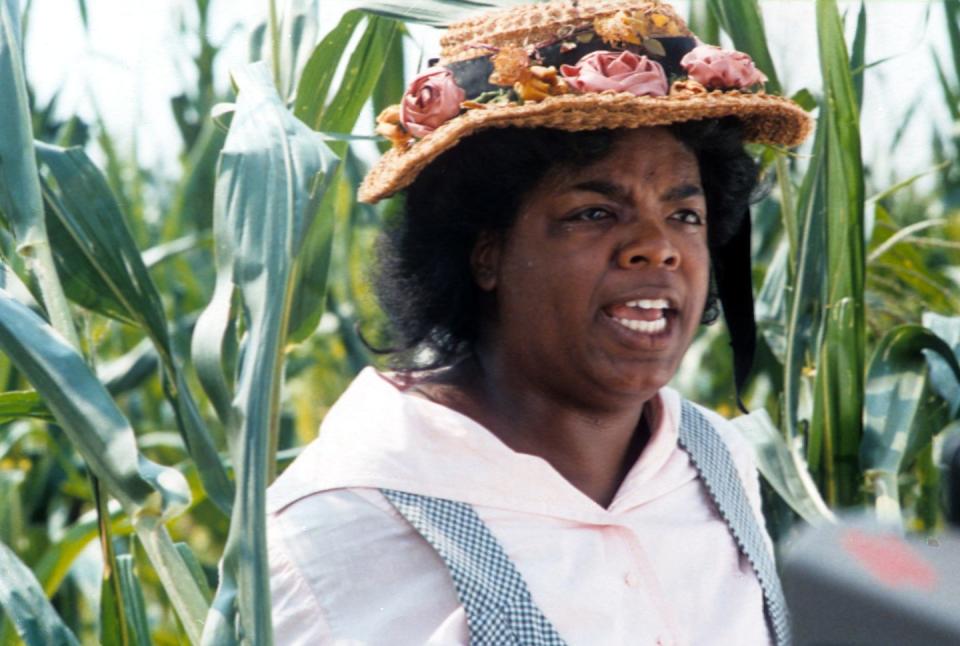Mad as a Mother

Like so many Black millennial women, I was raised on The Color Purple. I knew the movie as reference first, before I had the attention span or life experience to understand the full story. “She’s fixin’ to shave Mister,” my sisters and I would say to each other whenever we were about to do something especially vengeful. Or shout at each other, in mock tragedy, “Umma goonie Mama!” whenever we had to part from each other for longer than a night.
I had mixed feelings toward the movie, though, because there was one strand of the story that my mother always held up to me, in particular, as a cautionary tale. It was the story of Sophia, Miss Celie’s headstrong daughter-in-law. As played by a young Oprah Winfrey, Sophia always walks with one arm swinging by her side, as if she’s about to land a punch. In the brilliant costuming of the film, she wears her hat tilted down over her eyes—the universal symbol of a hothead. Early on, Sophia explains to Miss Celie, “All my life I’ve had to fight”—another line that quickly lost meaning and context, was made into a byword, which is what Black people always do to cherished pieces of pop culture. And Sophia does fight—she fights her husband and puts him out because he refuses to stand up to his father; she fights his new girlfriend for disrespecting her; she even fights the film’s abusive patriarch, Mister. She asserts herself until she doesn’t: Late in the film, a white woman in town—it’s the first time we see any of the characters meaningfully interact with any white women—sidles up to Sophia’s children and playfully asks if one of them would like to live with her and be her maid. Sophia says, “Hell, no” and a fight breaks loose. The white people take offense and surround Sophia—still raging, in sorrow now; as Winfrey plays her, you can see the dawn of desperation in her eyes—until one white hand reaches out of the crowd and hits her across the head with a brick. Strong, brave Sophia falls to the ground, and in a final humiliation, as her children are taken from her, her dress blows up for everyone to see.

“That’s what happens if you can’t control your anger,” my mother told me matter-of-factly whenever that scene came on. At six, I already had a reputation as a hothead myself. My family called it anger, but I don’t remember feeling angry as a kid—only the intense sense of being right about something and the frustration that nobody took me seriously, simply because they were so much bigger. When I got angry as a kid, it was mostly at that feeling—the baffling way the world decides who is worth listening to and who is not, which didn’t seem to be based on anything logical, only on what people decided seemed correct.
“That’s what happens when you get mad”: humiliation, degradation, complete loss of family and self. Sophia’s punishment in the movie is harsh—she lands in prison, is disfigured, the brick to her head makes her slow. She loses all sense of herself and ultimately ends up working as a maid in the same white woman’s house as part of her prison release, allowed to see her lost children for only one Christmas morning, cut short when her employer decides she can’t drive back home by herself.
That, understandably, terrified me. Which is what my mother meant to do. My mother went from being a respected member of the community, married to a Harvard-educated lawyer and living in the suburbs, to becoming the scourge of 1990s culture, a Black single mother, in the span of a year. Suddenly she too was made acutely aware of the world’s illogical determination of who was and was not worth listening to—and she knew she no longer was. I was in second grade when the divorce happened, young enough to still have tantrums in public on occasion, in theory. When I tried one, my mother told me—in quick, clear language muttered under her breath—“You act up like that and they’ll take you away from me. They’ll take you away from me so fast.”
The thing is—my mother was right. Boston was not an understanding place to raise three Black girls alone in the 1990s, especially if any one of them was any sort of unruly. She knew the punishment would be swift and harsh then too, with no promise of emotional redemption at an Easter dinner, as Sophia receives in the movie.
So I learned at a very young age to never get angry in public—and then it became to never get angry at all. Anger was a scary emotion; let loose, it could destroy your life. Most significantly, getting angry was what they—white people—wanted us to do. Everyone already called us angry Black women. I went to school in predominantly white places, and whenever some minor conflict came up, I could feel classmates slide their eyes over to me. “I was waiting for you to say something” was a constant refrain, one I prided myself on never satisfying. The way to combat all of this, I was taught, was never to get angry at all. Better to always walk away, never make a scene—and when you recounted whatever had happened to you, which anyone in their right mind would have gotten angry at, you were supposed to shrug your shoulders and claim you didn’t let it bother you. That you were above all of that. Sometimes you could toss in the perfectly scripted comeback—not too vulgar, because vulgarity was what they expected, too—you would have used on your tormentors, if your heart hadn’t been in your throat.
And then I had a daughter, and all of a sudden, all of that felt like supreme bullshit. Her birth was hard on me, and there were numerous times—when nurses lied, when the doctors ignored me, when the care given contradicted itself—when I knew another woman would have gotten angry. I wanted to get angry. But all I could feel was a distinct disconnect from any emotion at all—it was as if there were a large, placid lake and I stood on one shore, staring across to the other, where all of my real emotions were. In the past, I would have admired how glossy and still the surface of the water was. But now I only wanted to break it up, to swim across and reach sensation.
In the confusing months following my daughter’s birth, as I began to realize my whole life was not an authentic manifestation of how I wished to live, I flirted, for a few weeks, with Victorian despair. I wondered what it would mean to go full neurotic and let my anger and emotions come out in all the ways mothers are supposed to: overprotectiveness and hypervigilance and a neat disdain of anything six inches farther away than their baby’s face. But that didn’t feel right, either. I didn’t want to martyr myself on motherhood—I wanted to live a life joyful enough that my daughter could enjoy it, too.
To get there, I learned, there were good uses for anger. Anger was the fierce intensity that reminded me that my daughter and I deserved to live better, fuller lives. Anger was what reminded me of how hard I’d worked to feel stable enough to have a baby in the first place. Anger was what would propel me out of the mess I’d temporarily made, and anger was what saved me from self-pity.
I already plan on watching The Color Purple with my daughter, the same way my mother would make us watch old horse movies and my grandmother would show us Imitation of Life. Recently, I rewatched it again and Sophia was no longer a cautionary tale to me. “All my life I’ve had to fight,” she says to Celie—but only after the tortured and abused Celie, in a psychologically haunting move, tells Sophia’s husband he should beat her to control her. “All my life I’ve had to fight,” Sophia says, and then declares she will not fight her husband—the person who is supposed to be her place of solace and comfort. Her anger at his betrayal and attempts to abuse her propels her to leave him for something better, something she knows is out there and is certain is worthy of her. In her anger, she knows sweetness and rest are possible. It’s the mixed-up, confusing world that tells her it isn’t.
You Might Also Like

